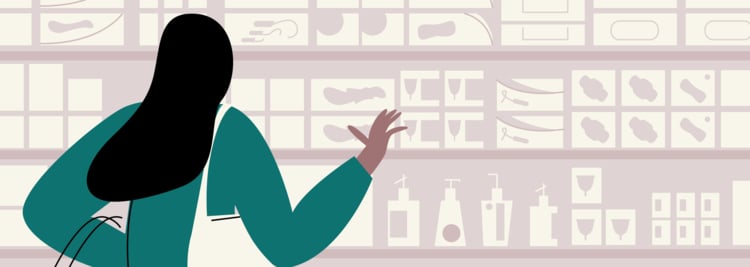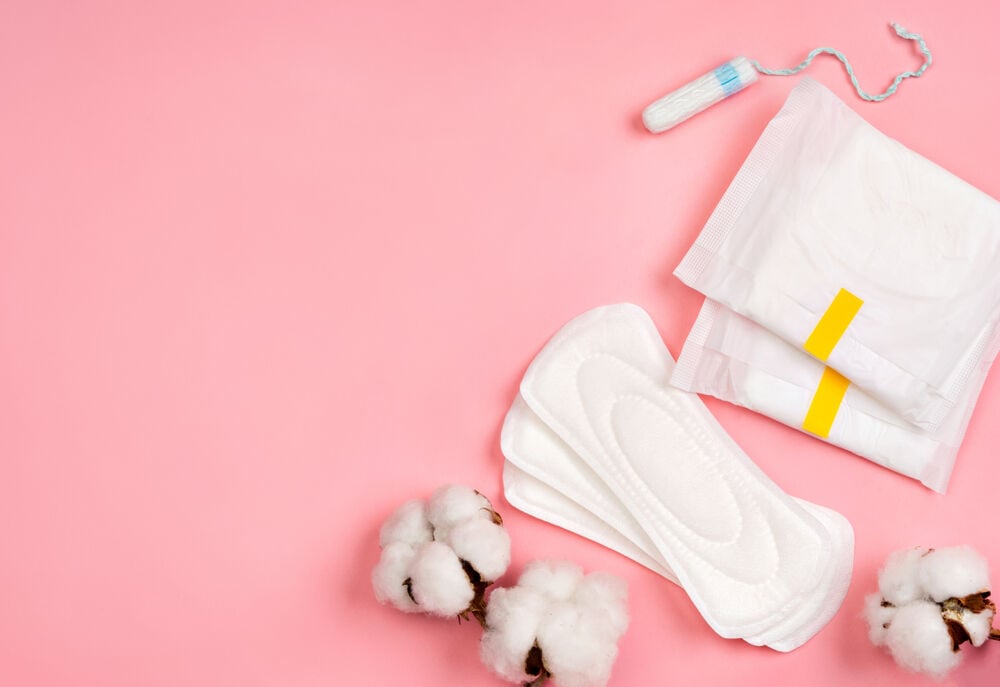There are many choices when it comes to period supplies. There are several ways to make your daily life easier when you have your period. We have compiled a list of several different period products available so you can pick the one that will best help you feel better on your period.
-
Tracking cycle
-
Getting pregnant
-
Pregnancy
-
Help Center
-
Flo for Partners
-
Anonymous Mode
-
Flo app reviews
-
Flo Premium New
-
Secret Chats New
-
Symptom Checker New
-
Your cycle
-
Health 360°
-
Getting pregnant
-
Pregnancy
-
Being a mom
-
LGBTQ+
-
Quizzes
-
Ovulation calculator
-
hCG calculator
-
Pregnancy test calculator
-
Menstrual cycle calculator
-
Period calculator
-
Implantation calculator
-
Pregnancy weeks to months calculator
-
Pregnancy due date calculator
-
IVF and FET due date calculator
-
Due date calculator by ultrasound
-
Medical Affairs
-
Science & Research
-
Pass It On Project New
-
Privacy Portal
-
Press Center
-
Flo Accuracy
-
Careers
-
Contact Us
Feminine Hygiene Products: A Complete Overview


Every piece of content at Flo Health adheres to the highest editorial standards for language, style, and medical accuracy. To learn what we do to deliver the best health and lifestyle insights to you, check out our content review principles.
What is meant by menstrual hygiene?
Menstrual hygiene is just genital hygiene during your period. There are several ways to care for your vagina during your period, including:
- Using period products — Tampons, cups, and pads fall into this category. They help collect or absorb menstrual blood, making it possible to go about your regular daily routine without too much hassle.
- Washing your genital area — Use clean, warm water on your genital area. Avoid using soap in or near your vagina. Wash with a soft washcloth so you can clean off any dried blood from your inner thighs or vulva. Keeping your genital area clean prevents blood from drying onto your skin. If the blood does dry, it can crack, which can cause skin pinching, hair pulling, and an irritated vulva. It’s very important to wash and wipe from front to back.
- Wearing comfortable, loose-fitting clothing — Your body holds onto fluid during your period and can get bloated. Wearing loose-fitting clothing can help provide some relief from bloating. Wearing tight clothing on your period can make your cramps and discomfort worse.
Keeping these three things in mind can help you feel better during your period.
Why menstrual hygiene is important
Menstrual hygiene is important because your vagina and vulva are very sensitive areas. Taking good care of yourself and practicing good menstrual hygiene can help keep you comfortable and healthy during your period.
The right period products can protect your clothing and any surfaces you’re sitting on, help maintain good hygiene, and provide you with comfort and confidence when going about your day.
What are the outcomes of poor menstrual hygiene?
Good menstrual hygiene helps you go about your day with ease and keeps you healthy.
Proper menstrual hygiene helps prevent:
- Urinary tract infections — Microbes can grow in old menstrual blood and cause inflammation of your vulva, vagina, and urethra, which can lead to a urinary tract infection. If you use reusable cloths to absorb your period blood, make sure to properly wash them. Change your pad or tampon regularly, and gently clean your vulva with warm water when needed.
- Genital rashes — Old blood can dry and stick to sensitive tissues, causing rashes on your genital area that may be itchy, swollen, and painful.
- Reproductive tract infection — Good hygiene can help prevent reproductive tract infections like yeast infections. Untreated infections can travel up your vaginal canal and damage your cervix.
In some areas, women aren’t able to practice good menstrual hygiene. Many women in rural India are at risk of developing health problems related to menstruation because they don’t have access to proper menstrual hygiene. Flo decided to raise money to supply Indian girls and women with much-needed period products to help them better manage their periods and protect their health.
Take a quiz
Find out what you can do with our Health Assistant
Feminine hygiene products

There are several types of period supplies to consider. Some women use only one type; others use a combination of two or more. When considering what you like, don’t be afraid to try them all. Every period is unique, and when you know how yours works, you can plan ahead and find the right tools to contain and control your flow.
Sanitary pads
Sanitary pads are great for lighter days. Many people use this product at the beginning and end of their period and when they’re sleeping. Pads come in many different sizes, so you can get various sizes for each stage of your period.
Pads are adhesive, with sticky material on stretchy “wings” and/or on the bottom of the product. Use the adhesive side of the pad to line your underwear, with the absorbent part on top. Most pads have super-absorbent technology inside them, but some are made of plastic materials, which can bother sensitive skin. Don’t forget to change your pad every four to six hours.
Tampons
Tampons are cotton-based products that are packed very tightly into either a cylindrical or a tent shape. A tampon is inserted into the vaginal canal, leaving a string that hangs out to help with removal later. As menstrual blood flows into the vaginal canal, the tampon absorbs the blood. The tampon is removed by pulling on the string.
Tampons were invented in the 1920s, though it took about a decade for a patent to arrive before they were available in stores. Tampons have helped people become more active during their periods. Some people wear a pad with a tampon to prevent any leaks during heavy flow days.
Tampons need to be changed regularly. If they stay in the vaginal canal for too long, bacterial toxins can lead to toxic shock syndrome (TSS). Changing your tampon every four to eight hours (and not using them while you’re sleeping) can help prevent TSS.
Menstrual cups
Menstrual cups are flexible, silicone-based cups. They can be pinched closed and inserted into the vagina. Unlike tampons that absorb blood, they catch and collect blood before it reaches the vaginal opening. They tend to hold more blood than a tampon and don’t present a risk for TSS.
To use a menstrual cup, simply insert it into the vagina so the open end is facing the cervix. Then go about your day. Remove the cup at least every 10 to 12 hours. Once you empty it into the toilet, you can wash and reinsert it. Many people prefer to use this product because of the excess waste tampons and pads create in landfills.
Period underwear
Period-proof underwear is a relatively new period product. It looks and feels like regular underwear but is designed with technology that absorbs and holds your period blood without the use of tampons, pads, or cups.
Period underwear has ultra-thin layers of material in the crotch. The layers create a moisture-wicking, odor-neutralizing, blood-absorbing, and leak-proof barrier. This offers you maximum comfort with minimal effort. To wash your used underwear, simply rinse in cold water, use a cold-water washing machine cycle, and line dry.
Panty liners
Panty liners are similar to pads but much less bulky. They are designed for light flow days and can help protect your clothing without the bulky feeling.
They have an adhesive side that sticks to your underwear, and they absorb menstrual blood.
Others
There are a few other products that some women use during their periods, including:
- Hair trimmers/razors — Menstrual blood can cling to pubic hair and cause it to stick to itself and pinch your skin. You can carefully trim or shave some of your pubic hair to prevent excessive sticking.
- Intimate gel washes — Sometimes menstruation alters the vagina’s pH balance, which can cause soreness and swelling and even increase the chances of a yeast infection. If you’re prone to yeast infections, try a gel wash designed to balance out your pH.
- Wet wipes — These wipes range from hypoallergenic baby wipes to medicated menstrual wipes with pH balancers. They offer a quick and portable option for freshening up when you’re on the go, especially if you have a heavy flow.
These products can help your genital area feel better during your period and might be good options to add to your monthly care routine.
The takeaway
Take charge of your menstrual flow. Choose the period products that work best for your lifestyle.
Your period is an important part of your reproductive health. When you feel clean, secure, and comfortable, you can go about your day normally. Try all the different methods and discover the period products that give you exactly the kind of protection you need.


Hey, I'm Anique
I started using Flo app to track my period and ovulation because we wanted to have a baby.


The Flo app helped me learn about my body and spot ovulation signs during our conception journey.


I vividly
remember the day
that we switched
Flo into
Pregnancy Mode — it was
such a special
moment.
Real stories, real results
Learn how the Flo app became an amazing cheerleader for us on our conception journey.




